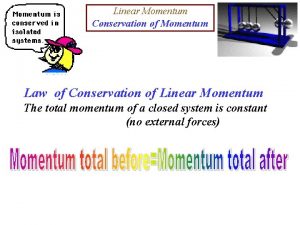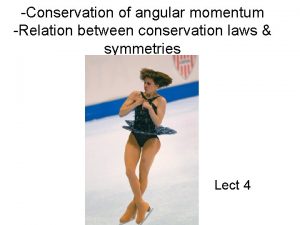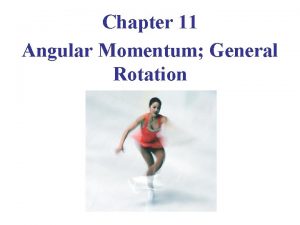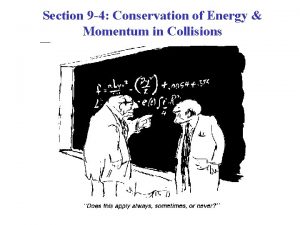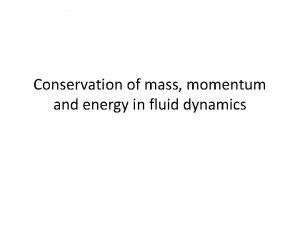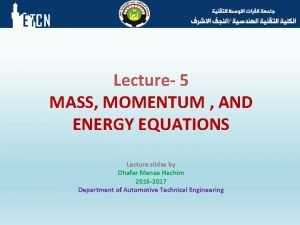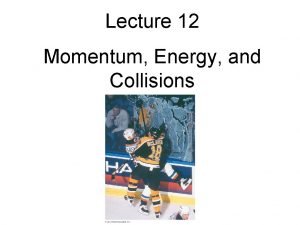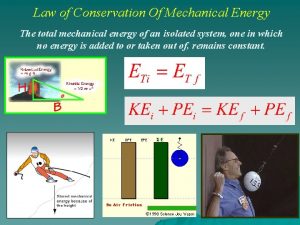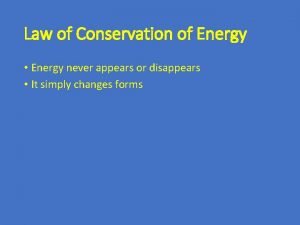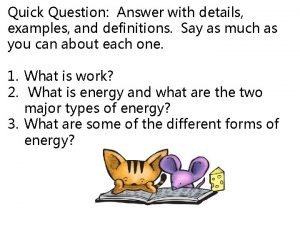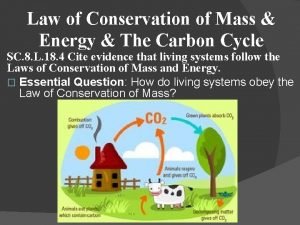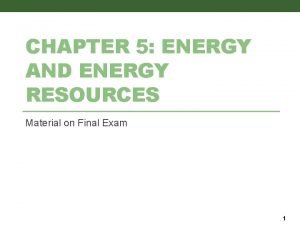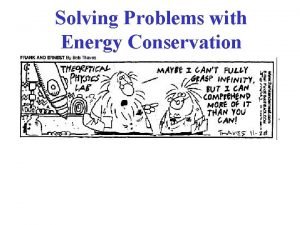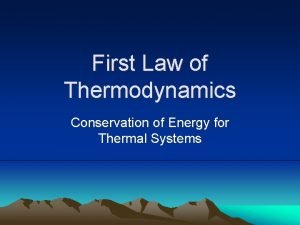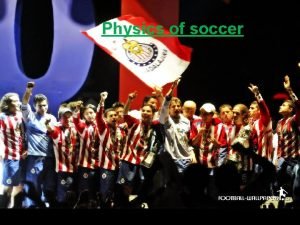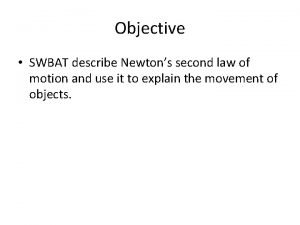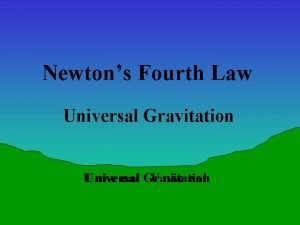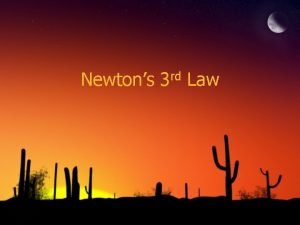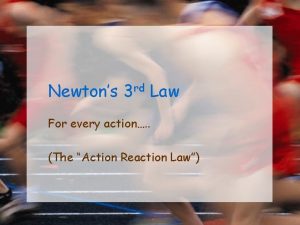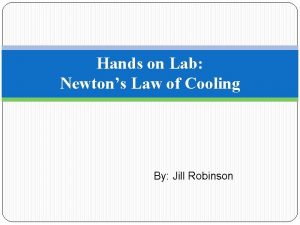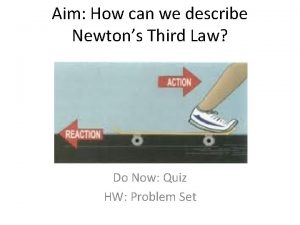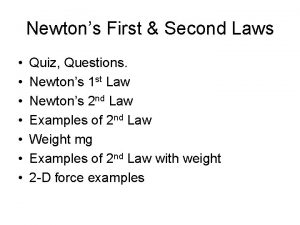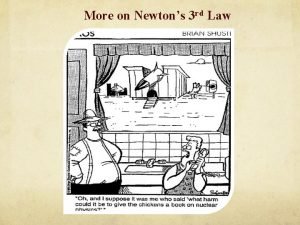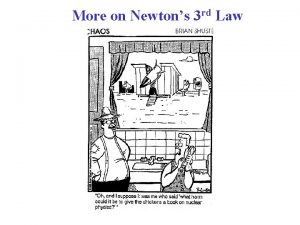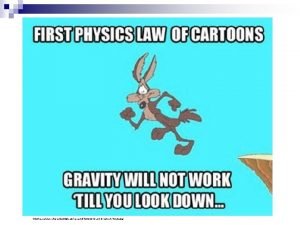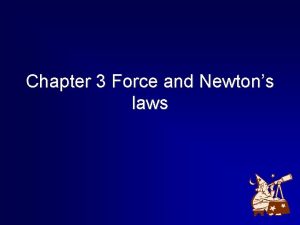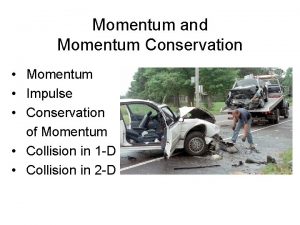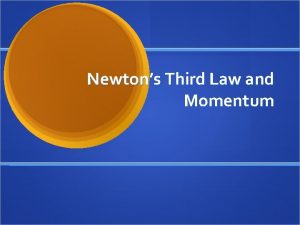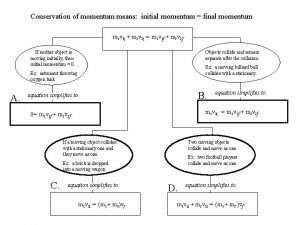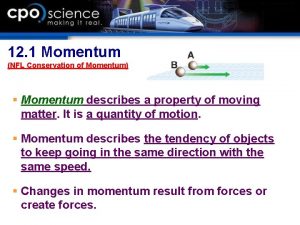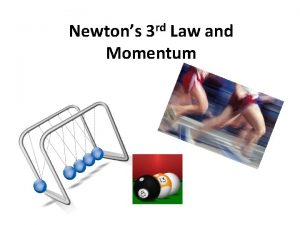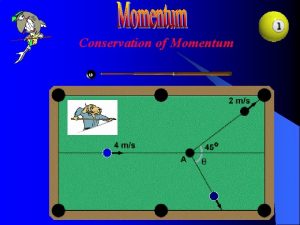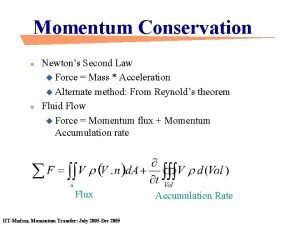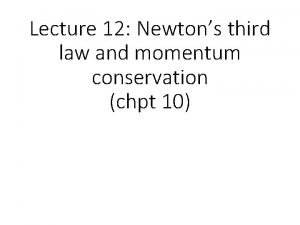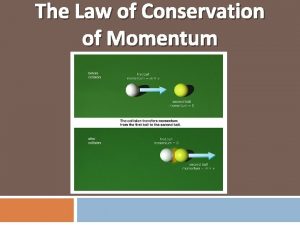Momentum Energy conservation Momentum Newtons 2 nd law
















































- Slides: 48

Momentum & Energy conservation

Momentum

Newton’s 2 nd law (shorthand version) F = ma change in v a = time F= m change in v time

Car truck collision Fc Fc = mc change in vc time Fc t = mc change in vc Ft Ft = mt change in vt time Ft t = mt change in vt Fc t + Ft t = mc change in vc + mt change in vt (Fc + Ft)t =change in mcvc + change in mtvt (Fc + Ft)t =change in (mcvc + mtvt)

Car truck collision Fc Ft (Fc + Ft)t =change in (mcvc + mtvt) Newton’s 3 rd law: Fc = -Ft (Fc + Ft)t = 0 0 = change in (mcvc + mtvt) mcvc + mtvt stays constant!

Momentum = mv mcvc = momentum of car this changes Mtvt= momentum of thruck this changes mcvc + mtvt = total momentum this stays constant Before = -40 After = -40 Momentum is conserved!

True for all collisions before =+20 after =+20 visit www. physicsclassroom. com/mmedia/index. html

Revisit the canoe at the dock Initial momentum canoe = 0 boy = 0 Total = 0 final momentum canoe = mcvc boy = mbvb Total = 0

Momentum is a vector: mv collision in 2 dimensions

eating Finding nemo

Billiard balls 2 before 1 ptot after 2 1 ptot

Conservation of momentum on a sub-atomic level before p ptot p proton p- meson after p p p- meson ptot

Rocket travel before P 0 after exhaust p P 0 + p

Rifle recoil m. V m V

Machine-gun granny

Work and Energy

Physicist’s definition of “work” dist∥ (n A s ot ca a lar ve ct or ) dist Work = F x dist∥

Atlas holds up the Earth But he doesn’t move, dist∥ = 0 Work= Fx dist∥ = 0 He doesn’t do any work!

Garcon does work when he picks up the tray but not while he carries it around the room dist is not zero, but dist∥ is 0

Why this r o t n c definition? ve atio A qu e Newton’s 2 nd law: A eq sca ua lar tio n F=m a Definition of work + a little calculus Work= change in ½mv 2 This scalar quantity is given a special name: kinetic energy

Concept of Kinetic Energy Emilie du Châtelet (1706 -1749) Brilliant mathematician One of Voltaire’s lovers

Work = change in KE This is called: the Work-Energy Theorem

Units again… Kinetic Energy = ½mv 2 work = F x dist∥ 2 m kg 2 s same! m N m =kg 2 m s =1 Joule

Work done by gravity end start dist∥ change in vertical height W=mg Work = F = x dist∥ -mg x change in height = -change in mg h

Gravitational Potential Energy Workgrav = -change in mgh This is called: “Gravitational Potential Energy” (or PEgrav) change Workgrav in = PE-change in PE grav = -Work grav

If gravity is the only force doing work…. Work-energy theorem: -change in mgh = change in ½ mv 2 0 = change in mgh + change in ½ mv 2 change in (mgh + ½ mv 2) = 0 mgh + ½ mv 2 = constant

Conservation of energy mgh + ½ mv 2 = constant Gravitational Potential energy Kinetic energy If gravity is the only force that does work: PE + KE = constant Energy is conserved

Free fall height (reminder) t = 0 s V 0 = 0 t = 1 s 80 m 75 m V 1 = 10 m/s 60 m t = 2 s V 2 = 20 m/s t = 3 s 35 m V 3 = 30 m/s t = 4 s V 4 = 40 m/s 0 m

m=1 kg free falls from 80 m t = 0 s V 0 = 0 h 0=80 m mgh 800 J ½ mv 2 sum 0 800 J 50 J 800 J t = 1 s V 1 = 10 m/s; h 1=75 m 750 J t = 2 s V 2 = 20 m/s; h 2=60 m 600 J 200 J 800 J 350 J 450 J 800 J t = 3 s V 3 = 30 m/s; h 3=35 m t = 4 s V 4 = 40 m/s; h 4=0 0 800 J

pendulum T W=mg Two forces: T and W T is always to the motion (& does no work) ┴

Pendulum conserves energy Etot=mghmax Etot=1/2 m(vmax)2

Roller coaster

Work done by a spring Relaxed Position F=0 F x I compress the spring (I do + work; spring does -work) Work done by spring = - change in ½ kx 2

If spring is the only force doing work…. Work-energy theorem: -change in ½ kx 2 = change in ½ mv 2 0 = change in ½ kx 2 + change in ½ mv 2 change in ( ½ kx 2 + ½ mv 2) = 0 ½ kx 2 + ½ mv 2 = constant potential energy in the spring

Conservation of energy springs & gravity mgh + ½ kx 2 + ½ mv 2 = constant Gravitational spring potential energy Kinetic energy If elastic force & gravity are the only forces doing work: PEgrav + PEspring + KE = constant Energy is conserved

example grav PE Kinetic. E Spring PE

Two types of forces: “Conservative” forces that do + & – work “Dissipative” • Gravity • Friction • Elastic (springs, etc) • Viscosity • Electrical forces • … -work heat -work change in PE forces that only do – work (no potential energy. )

(-)Work done by friction heat

Thermal atomic motion Air solid Heat energy= KE and PE associated with the random thermal motion of atoms

Work-energy theorem (all forces) Workfric = Work done dissipative Forces (always -) change in (PE+KE) potential energy From all Conservative forces Kinetic energy -Work change in in heat energy Work -change fric = = fric -change = (PE+KE) in Heat Energy change in

Work – Energy Theorem (all forces) 0 = change in 0 = + (PE+KE) change in Heat Energy (Heat Energy+PE+KE) + PE + KE = constant Law of Conservation of Energy

Energy conversion while skiing Potential energy kinetic energy Friction: energy gets converted to heat

Units again Heat units: 1 calorie = heat energy required to raise the temp of 1 gram of H 2 O by 1 o C Kg m 2/s 2 1 calorie= 4. 18 Joules

Food Calories 1 Calorie = 1000 calories = 1 Kcalorie The Calories you read on food labels 1 Calorie= 4. 18 x 103 Joules 7 x 106 J 8 x 105 J 2 x 106 J

Power Rate of using energy: Units: Joule 1 second amout of energy Power = elapsed time = 1 Watt A 100 W light bulb consumes 100 J of electrical energy each second to produce light

Other units Over a full day, a work-horse can have an average work output of more than 750 Joules each second 1 Horsepower = 750 Watts

Kilowatt hours energy Power = time energy = power unit Elec companies use: x Kilowatts (103 W) x time unit = energy unit x hours (3600 s) 1 kilowatt-hour = 1 k. W-hr = 103 W x 3. 6 x 103 s = 3. 6 x 106 Ws J

on w 300 t u abo In Hawaii electrical energy costs about 25 cents /k. W-hr What is the cost in Seoul?
 Cannonball
Cannonball How momentum conservation is applied in vehicular accidents
How momentum conservation is applied in vehicular accidents Law of conservation of momentum animation
Law of conservation of momentum animation Law of conservation of angular momentum
Law of conservation of angular momentum Angular momentum units
Angular momentum units Two cans of spam with identical masses collide
Two cans of spam with identical masses collide Conservation of momentum
Conservation of momentum The law of conservation of momentum
The law of conservation of momentum Ideal fluid
Ideal fluid Conservation of mass momentum and energy equations
Conservation of mass momentum and energy equations Conservation of momentum and energy
Conservation of momentum and energy What is kinetic energy
What is kinetic energy Conservation of mechanical energy formula
Conservation of mechanical energy formula Law of conservation of energy worksheets
Law of conservation of energy worksheets Energy conservation law
Energy conservation law Law of conservation of energy example
Law of conservation of energy example Conservation of mechanical energy
Conservation of mechanical energy Formula for total mechanical energy
Formula for total mechanical energy Term 3 natural science grade 7
Term 3 natural science grade 7 The law of conservation of energy states that
The law of conservation of energy states that Potential energy vs kinetic energy
Potential energy vs kinetic energy Conservation of energy
Conservation of energy Conservation of energy
Conservation of energy The law of conservation of energy states that
The law of conservation of energy states that How to solve mechanical energy
How to solve mechanical energy First law of td
First law of td Chapter 7 energy conservation of energy
Chapter 7 energy conservation of energy Newtons 3 rd law of motion
Newtons 3 rd law of motion Physics
Physics Describe newtons second law
Describe newtons second law Newton first law examples
Newton first law examples фанфик newton's fourth law
фанфик newton's fourth law Newtons 3 rd law of motion
Newtons 3 rd law of motion Newtons 3 rd law of motion
Newtons 3 rd law of motion Newton's 3 law
Newton's 3 law Newtons 3 rd law
Newtons 3 rd law Newton’s cooling law
Newton’s cooling law Describe newtons third law
Describe newtons third law Newton's third law of thermodynamics
Newton's third law of thermodynamics Newtons 1law
Newtons 1law Third law of motion
Third law of motion Newtons law quiz
Newtons law quiz Newtons 3 rd law of motion
Newtons 3 rd law of motion Newtons 3 rd law
Newtons 3 rd law Action reaction forces
Action reaction forces Newtons 3 rd law
Newtons 3 rd law Newtons 3 rd law example
Newtons 3 rd law example Newton's 1st law meme
Newton's 1st law meme Section 3 using newtons laws
Section 3 using newtons laws


